Yichen Xu
POLYCHARTQA: Benchmarking Large Vision-Language Models with Multilingual Chart Question Answering
Jul 16, 2025Abstract:Charts are a universally adopted medium for interpreting and communicating data. However, existing chart understanding benchmarks are predominantly English-centric, limiting their accessibility and applicability to global audiences. In this paper, we present PolyChartQA, the first large-scale multilingual chart question answering benchmark covering 22,606 charts and 26,151 question-answering pairs across 10 diverse languages. PolyChartQA is built using a decoupled pipeline that separates chart data from rendering code, allowing multilingual charts to be flexibly generated by simply translating the data and reusing the code. We leverage state-of-the-art LLM-based translation and enforce rigorous quality control in the pipeline to ensure the linguistic and semantic consistency of the generated multilingual charts. PolyChartQA facilitates systematic evaluation of multilingual chart understanding. Experiments on both open- and closed-source large vision-language models reveal a significant performance gap between English and other languages, especially low-resource ones with non-Latin scripts. This benchmark lays a foundation for advancing globally inclusive vision-language models.
Residual Feature Integration is Sufficient to Prevent Negative Transfer
May 17, 2025Abstract:Transfer learning typically leverages representations learned from a source domain to improve performance on a target task. A common approach is to extract features from a pre-trained model and directly apply them for target prediction. However, this strategy is prone to negative transfer where the source representation fails to align with the target distribution. In this article, we propose Residual Feature Integration (REFINE), a simple yet effective method designed to mitigate negative transfer. Our approach combines a fixed source-side representation with a trainable target-side encoder and fits a shallow neural network on the resulting joint representation, which adapts to the target domain while preserving transferable knowledge from the source domain. Theoretically, we prove that REFINE is sufficient to prevent negative transfer under mild conditions, and derive the generalization bound demonstrating its theoretical benefit. Empirically, we show that REFINE consistently enhances performance across diverse application and data modalities including vision, text, and tabular data, and outperforms numerous alternative solutions. Our method is lightweight, architecture-agnostic, and robust, making it a valuable addition to the existing transfer learning toolbox.
Goal State Generation for Robotic Manipulation Based on Linguistically Guided Hybrid Gaussian Diffusion
Dec 25, 2024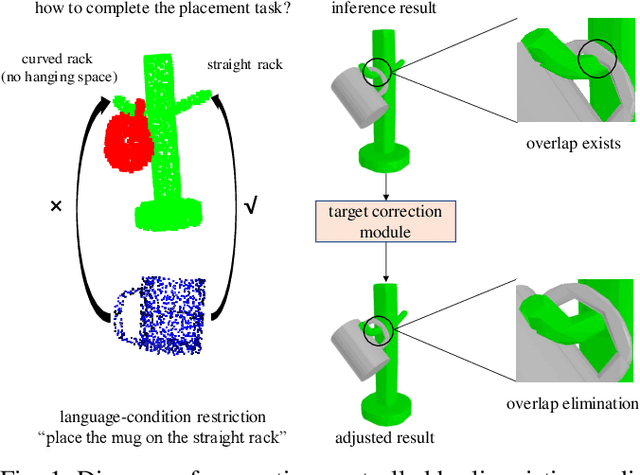
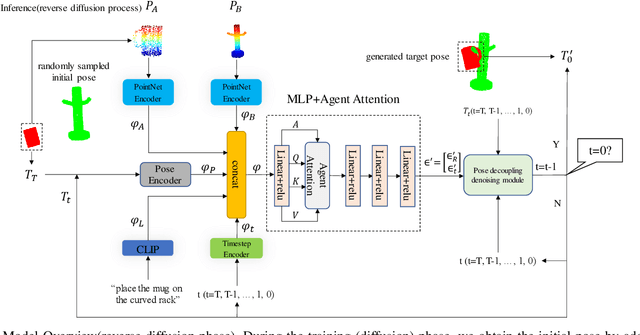
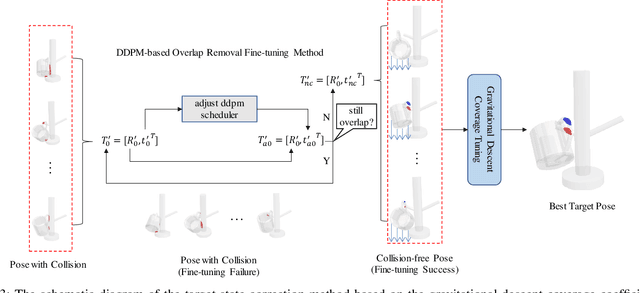
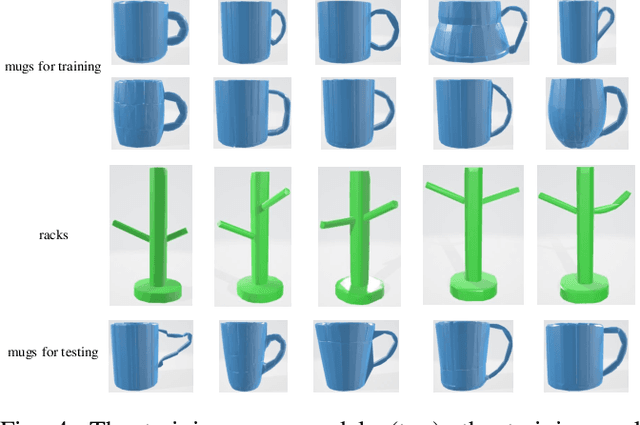
Abstract:In robotic manipulation tasks, achieving a designated target state for the manipulated object is often essential to facilitate motion planning for robotic arms. Specifically, in tasks such as hanging a mug, the mug must be positioned within a feasible region around the hook. Previous approaches have enabled the generation of multiple feasible target states for mugs; however, these target states are typically generated randomly, lacking control over the specific generation locations. This limitation makes such methods less effective in scenarios where constraints exist, such as hooks already occupied by other mugs or when specific operational objectives must be met. Moreover, due to the frequent physical interactions between the mug and the rack in real-world hanging scenarios, imprecisely generated target states from end-to-end models often result in overlapping point clouds. This overlap adversely impacts subsequent motion planning for the robotic arm. To address these challenges, we propose a Linguistically Guided Hybrid Gaussian Diffusion (LHGD) network for generating manipulation target states, combined with a gravity coverage coefficient-based method for target state refinement. To evaluate our approach under a language-specified distribution setting, we collected multiple feasible target states for 10 types of mugs across 5 different racks with 10 distinct hooks. Additionally, we prepared five unseen mug designs for validation purposes. Experimental results demonstrate that our method achieves the highest success rates across single-mode, multi-mode, and language-specified distribution manipulation tasks. Furthermore, it significantly reduces point cloud overlap, directly producing collision-free target states and eliminating the need for additional obstacle avoidance operations by the robotic arm.
Hierarchical Diffusion Policy: manipulation trajectory generation via contact guidance
Nov 20, 2024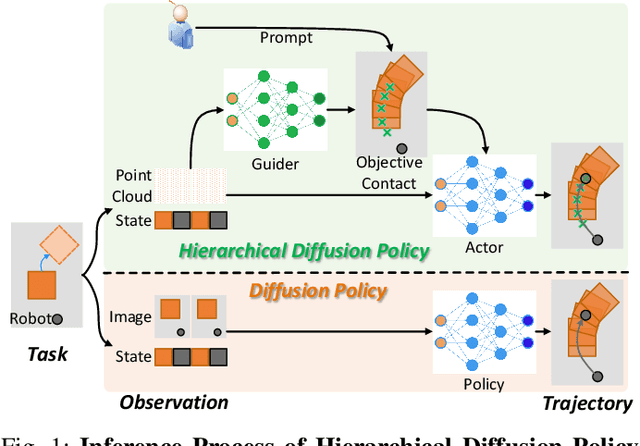
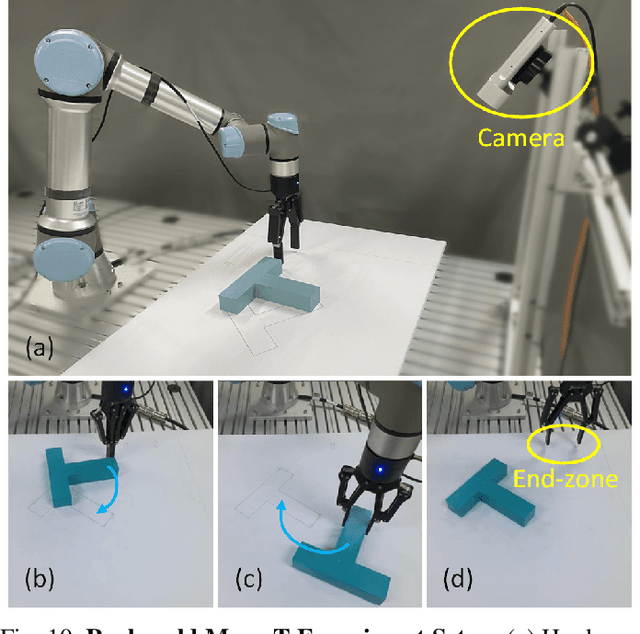
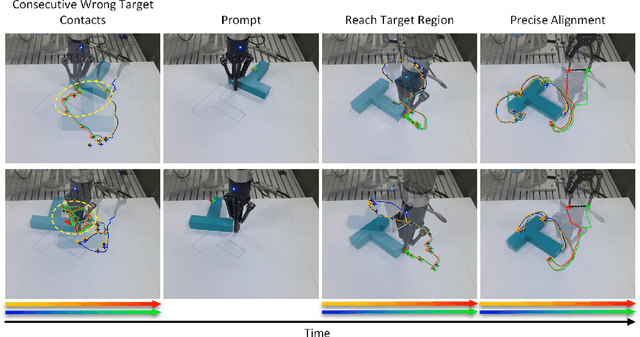
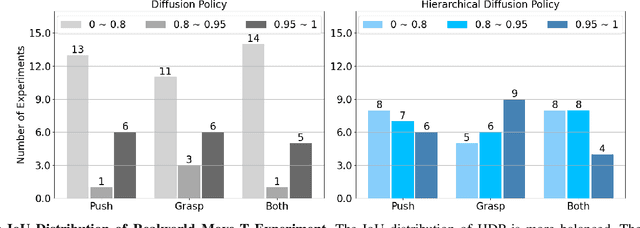
Abstract:Decision-making in robotics using denoising diffusion processes has increasingly become a hot research topic, but end-to-end policies perform poorly in tasks with rich contact and have limited controllability. This paper proposes Hierarchical Diffusion Policy (HDP), a new imitation learning method of using objective contacts to guide the generation of robot trajectories. The policy is divided into two layers: the high-level policy predicts the contact for the robot's next object manipulation based on 3D information, while the low-level policy predicts the action sequence toward the high-level contact based on the latent variables of observation and contact. We represent both level policies as conditional denoising diffusion processes, and combine behavioral cloning and Q-learning to optimize the low level policy for accurately guiding actions towards contact. We benchmark Hierarchical Diffusion Policy across 6 different tasks and find that it significantly outperforms the existing state of-the-art imitation learning method Diffusion Policy with an average improvement of 20.8%. We find that contact guidance yields significant improvements, including superior performance, greater interpretability, and stronger controllability, especially on contact-rich tasks. To further unlock the potential of HDP, this paper proposes a set of key technical contributions including snapshot gradient optimization, 3D conditioning, and prompt guidance, which improve the policy's optimization efficiency, spatial awareness, and controllability respectively. Finally, real world experiments verify that HDP can handle both rigid and deformable objects.
Synthetic Oversampling: Theory and A Practical Approach Using LLMs to Address Data Imbalance
Jun 05, 2024Abstract:Imbalanced data and spurious correlations are common challenges in machine learning and data science. Oversampling, which artificially increases the number of instances in the underrepresented classes, has been widely adopted to tackle these challenges. In this article, we introduce OPAL (\textbf{O}versam\textbf{P}ling with \textbf{A}rtificial \textbf{L}LM-generated data), a systematic oversampling approach that leverages the capabilities of large language models (LLMs) to generate high-quality synthetic data for minority groups. Recent studies on synthetic data generation using deep generative models mostly target prediction tasks. Our proposal differs in that we focus on handling imbalanced data and spurious correlations. More importantly, we develop a novel theory that rigorously characterizes the benefits of using the synthetic data, and shows the capacity of transformers in generating high-quality synthetic data for both labels and covariates. We further conduct intensive numerical experiments to demonstrate the efficacy of our proposed approach compared to some representative alternative solutions.
TinyChart: Efficient Chart Understanding with Visual Token Merging and Program-of-Thoughts Learning
Apr 25, 2024Abstract:Charts are important for presenting and explaining complex data relationships. Recently, multimodal large language models (MLLMs) have shown remarkable capabilities in various chart understanding tasks. However, the sheer size of these models in terms of parameters and computational requirements limits their use in resource-constrained environments. In this paper, we present TinyChart, an efficient MLLM for chart understanding with only 3B parameters. TinyChart overcomes two key challenges in efficient chart understanding: (1) reduce the burden of learning numerical computations through a Program-of-Thoughts (PoT) learning strategy, which trains the model to generate Python programs for numerical calculations, and (2) reduce lengthy vision feature sequences produced by the vision transformer for high-resolution images through a Vision Token Merging module, which gradually merges most similar vision tokens. Extensive experiments demonstrate that our 3B TinyChart achieves SOTA performance on a variety of chart understanding benchmarks including ChartQA, Chart-to-Text, Chart-to-Table, OpenCQA, and ChartX. It outperforms several chart understanding MLLM with up to 13B parameters such as ChartLlama and ChartAst, and close-sourced general-purpose MLLM GPT-4V on ChartQA. It also demonstrates its superior efficiency with higher throughput during inference due to a smaller model scale and more efficient vision encoding. Our code and model are available at https://github.com/X-PLUG/mPLUG-DocOwl/tree/main/TinyChart.
VersaT2I: Improving Text-to-Image Models with Versatile Reward
Mar 27, 2024Abstract:Recent text-to-image (T2I) models have benefited from large-scale and high-quality data, demonstrating impressive performance. However, these T2I models still struggle to produce images that are aesthetically pleasing, geometrically accurate, faithful to text, and of good low-level quality. We present VersaT2I, a versatile training framework that can boost the performance with multiple rewards of any T2I model. We decompose the quality of the image into several aspects such as aesthetics, text-image alignment, geometry, low-level quality, etc. Then, for every quality aspect, we select high-quality images in this aspect generated by the model as the training set to finetune the T2I model using the Low-Rank Adaptation (LoRA). Furthermore, we introduce a gating function to combine multiple quality aspects, which can avoid conflicts between different quality aspects. Our method is easy to extend and does not require any manual annotation, reinforcement learning, or model architecture changes. Extensive experiments demonstrate that VersaT2I outperforms the baseline methods across various quality criteria.
URHand: Universal Relightable Hands
Jan 10, 2024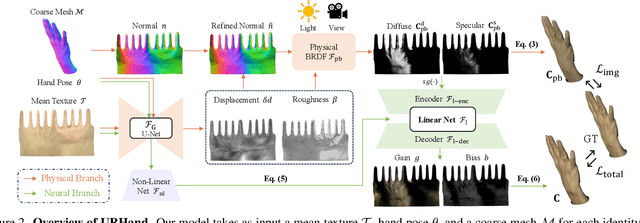
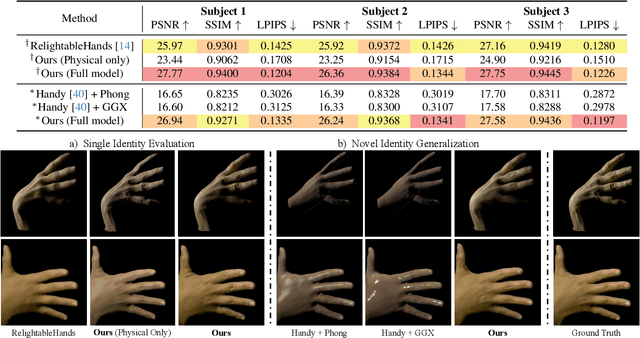

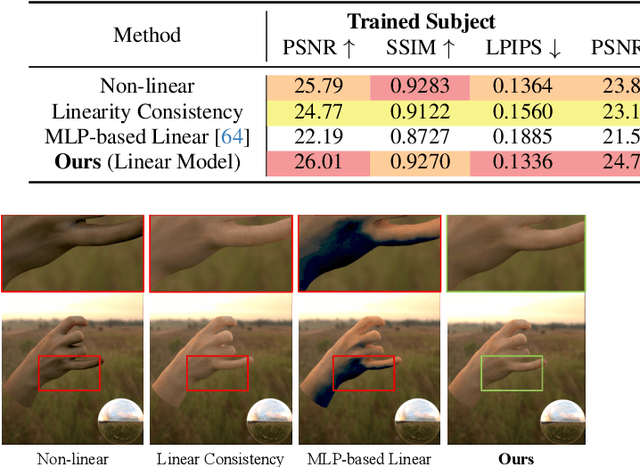
Abstract:Existing photorealistic relightable hand models require extensive identity-specific observations in different views, poses, and illuminations, and face challenges in generalizing to natural illuminations and novel identities. To bridge this gap, we present URHand, the first universal relightable hand model that generalizes across viewpoints, poses, illuminations, and identities. Our model allows few-shot personalization using images captured with a mobile phone, and is ready to be photorealistically rendered under novel illuminations. To simplify the personalization process while retaining photorealism, we build a powerful universal relightable prior based on neural relighting from multi-view images of hands captured in a light stage with hundreds of identities. The key challenge is scaling the cross-identity training while maintaining personalized fidelity and sharp details without compromising generalization under natural illuminations. To this end, we propose a spatially varying linear lighting model as the neural renderer that takes physics-inspired shading as input feature. By removing non-linear activations and bias, our specifically designed lighting model explicitly keeps the linearity of light transport. This enables single-stage training from light-stage data while generalizing to real-time rendering under arbitrary continuous illuminations across diverse identities. In addition, we introduce the joint learning of a physically based model and our neural relighting model, which further improves fidelity and generalization. Extensive experiments show that our approach achieves superior performance over existing methods in terms of both quality and generalizability. We also demonstrate quick personalization of URHand from a short phone scan of an unseen identity.
Devil in the Number: Towards Robust Multi-modality Data Filter
Sep 24, 2023



Abstract:In order to appropriately filter multi-modality data sets on a web-scale, it becomes crucial to employ suitable filtering methods to boost performance and reduce training costs. For instance, LAION papers employs the CLIP score filter to select data with CLIP scores surpassing a certain threshold. On the other hand, T-MARS achieves high-quality data filtering by detecting and masking text within images and then filtering by CLIP score. Through analyzing the dataset, we observe a significant proportion of redundant information, such as numbers, present in the textual content. Our experiments on a subset of the data unveil the profound impact of these redundant elements on the CLIP scores. A logical approach would involve reevaluating the CLIP scores after eliminating these influences. Experimentally, our text-based CLIP filter outperforms the top-ranked method on the ``small scale" of DataComp (a data filtering benchmark) on ImageNet distribution shifts, achieving a 3.6% performance improvement. The results also demonstrate that our proposed text-masked filter outperforms the original CLIP score filter when selecting the top 40% of the data. The impact of numbers on CLIP and their handling provide valuable insights for improving the effectiveness of CLIP training, including language rewrite techniques.
A Survey on Pretrained Language Models for Neural Code Intelligence
Dec 20, 2022


Abstract:As the complexity of modern software continues to escalate, software engineering has become an increasingly daunting and error-prone endeavor. In recent years, the field of Neural Code Intelligence (NCI) has emerged as a promising solution, leveraging the power of deep learning techniques to tackle analytical tasks on source code with the goal of improving programming efficiency and minimizing human errors within the software industry. Pretrained language models have become a dominant force in NCI research, consistently delivering state-of-the-art results across a wide range of tasks, including code summarization, generation, and translation. In this paper, we present a comprehensive survey of the NCI domain, including a thorough review of pretraining techniques, tasks, datasets, and model architectures. We hope this paper will serve as a bridge between the natural language and programming language communities, offering insights for future research in this rapidly evolving field.
 Add to Chrome
Add to Chrome Add to Firefox
Add to Firefox Add to Edge
Add to Edge